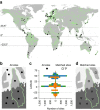Local biodiversity is higher inside than outside terrestrial protected areas worldwide
- PMID: 27465407
- PMCID: PMC4974472
- DOI: 10.1038/ncomms12306
Local biodiversity is higher inside than outside terrestrial protected areas worldwide
Abstract
Protected areas are widely considered essential for biodiversity conservation. However, few global studies have demonstrated that protection benefits a broad range of species. Here, using a new global biodiversity database with unprecedented geographic and taxonomic coverage, we compare four biodiversity measures at sites sampled in multiple land uses inside and outside protected areas. Globally, species richness is 10.6% higher and abundance 14.5% higher in samples taken inside protected areas compared with samples taken outside, but neither rarefaction-based richness nor endemicity differ significantly. Importantly, we show that the positive effects of protection are mostly attributable to differences in land use between protected and unprotected sites. Nonetheless, even within some human-dominated land uses, species richness and abundance are higher in protected sites. Our results reinforce the global importance of protected areas but suggest that protection does not consistently benefit species with small ranges or increase the variety of ecological niches.
Figures




References
-
- Geldmann J. et al.. Effectiveness of terrestrial protected areas in reducing habitat loss and population declines. Biol. Conserv. 161, 230–238 (2013).
-
- Juffe-Bignoli D. et al.. Protected Planet Report 2014. Available at http://www.unep-wcmc.org/resources-and-data/protected-planet-report-2014 (UNEP-WCMC, 2014).
-
- CBD. Decision X/2, The strategic plan for biodiversity 2011–2020 and the Aichi Biodiversity Targets, Nagoya, Japan, 18 to 29 October 2010. Available at http://www.cbd.int/decision/cop/default.shtml?id=13164 (2010).
-
- Tittensor D. P. et al.. A mid-term analysis of progress toward international biodiversity targets. Science 346, 241–244 (2014). - PubMed
-
- Leverington F., Costa K. L., Pavese H., Lisle A. & Hockings M. A global analysis of protected area management effectiveness. Env. Manag. 46, 685–698 (2010). - PubMed
Publication types
MeSH terms
LinkOut - more resources
Full Text Sources
Other Literature Sources

